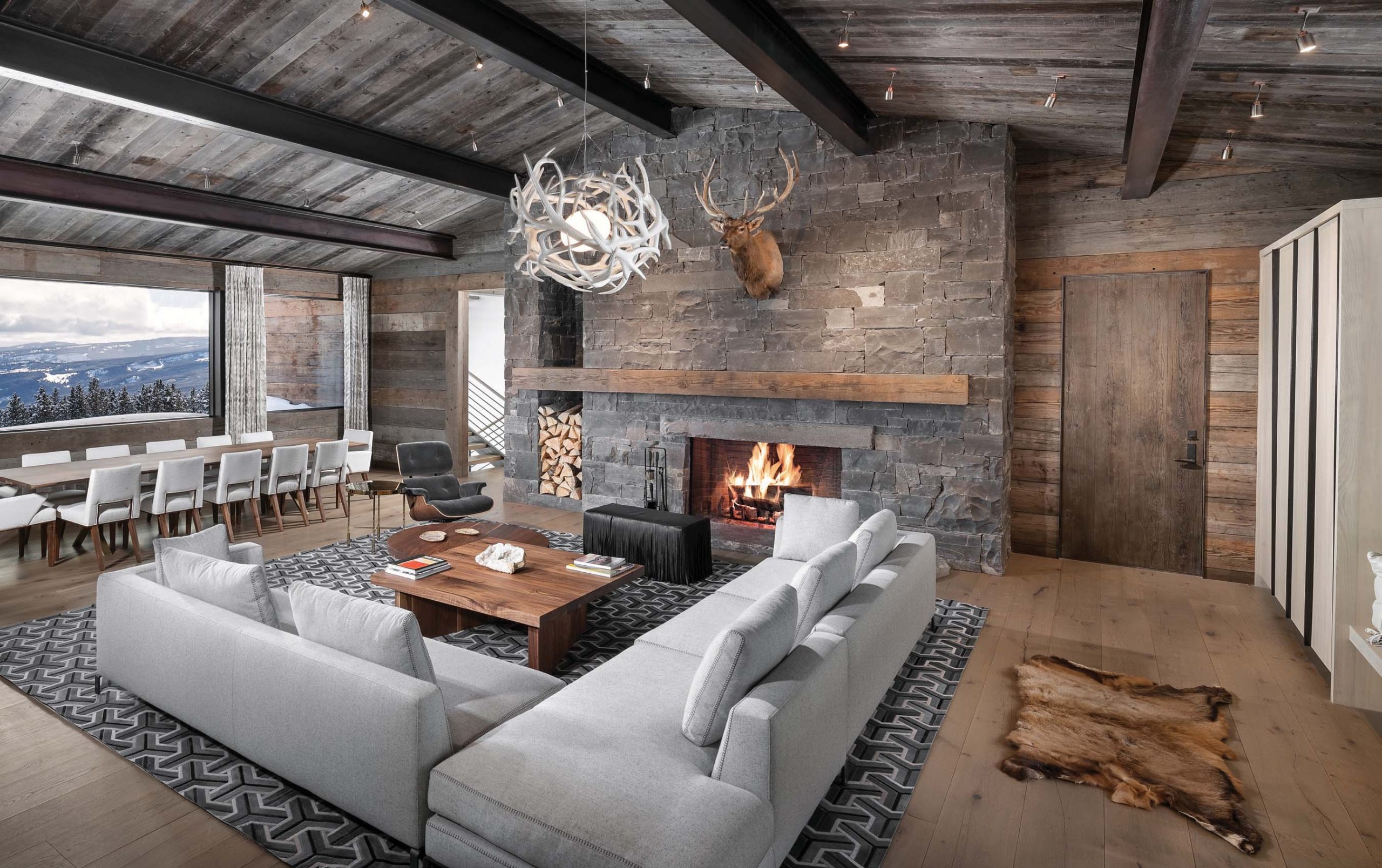
22 Nov WESTERN DESIGN: LIGHT AND LIVELY
Ski-in, ski-out was the driving concept behind the design of a home up on a ridge in the Yellowstone Club near Big Sky, Montana. And it made perfect sense for a young family from back East intent on tackling the challenges of the snow and slopes out West.
“It’s like being on the beachfront if you lived near the ocean,” quips Todd Thesing, co-founder of Highline Partners, the builders based in Bozeman and Big Sky who turned this 9,000-square-foot chalet into a reality. Highline worked with Pearson Design Group, Suede Studio, and Design 5 Landscape Architecture on this prime-time ski-access residence.
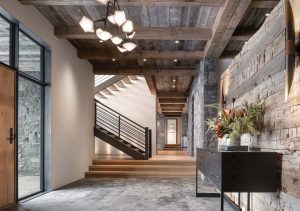
Light and welcoming thanks to an abundance of windows and soft neutrals, the entry opens to a timbered wall and open stairwell.
The home is tailored to its environment and the winter sport that brings people to Montana in droves. “You wake up, go to the ski room, and put on your gear,” Thesing says. “Then you ski down to the chairlift, go up, and ski down. Repeat and repeat again — and at the end of the day, you reverse the process.”
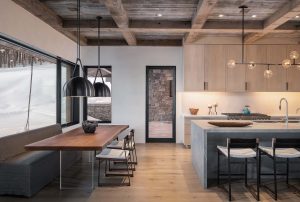
Pearson Design Group created a social space in the kitchen that also showcases the expansive views and immediate access to skiing.
Back at the chalet, a hot tub awaits, along with a sauna and cold beer. Or there’s company to keep and a grand vista of the valley below to enjoy. “You come up into the social space with the bar and the view,” says Justin Tollefson, managing principal for Pearson Design Group, also based in Bozeman. “The bigger view is behind you, and it’s all downhill.”
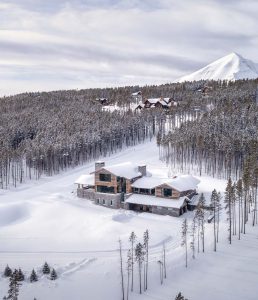
On a gently sloping site, the home is steps away from a ski run.
The home is inserted into a wooded area at the top of a site that’s a little over 2 acres and full of lodgepole pines. Fifty years ago, the area was part of a timber forest that was clearcut and regrown. But here, Troy Scherer of Design 5 Landscape Architecture in Bozeman thinned the trees just enough to create space to ski through, then selectively added native and adaptive trees. Among them are Engelmann spruce and more lodgepole pines deliberately chosen to grow skinny and tall.
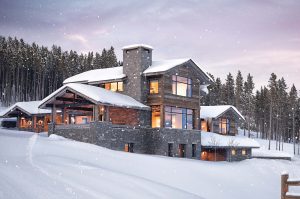
The home is 9,000 square feet and includes six bedrooms.
For the warmer months, the client wanted his home to feel like it was sited in a mountain’s meadowy field, so Scherer added grass and flowers for drifts of color and an informal cascade of stone. He eschewed the idea of retaining walls to avoid making the hardscape feel forced. “The patio boulders are set in a certain way,” he says. “There’s a fit and finish that’s Mountain Modern — with rough but clean edges.”
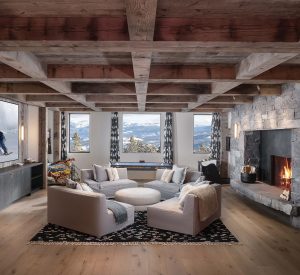
The architects utilized organic materials throughout, like basalt stone and reclaimed timber. They offset the heavy materiality with an abundance of glass to bring views to the fore.
The home’s form is a defining example of Pearson Design Group’s philosophy of how homes and their inhabitants should interact. “We have a kind of simple answer for design,” Tollefson says. “Regardless of the aesthetics or where it is — lake, river, or ski slope — it’s about how we connect people and families to each other and to the land.” They believe a home is meant for certain rituals that are shared by family and friends outdoors. “It’s about the environment — like downhill skiing or just being in the mountains,” he says. “And we have these wonderful things here: amazing views and daylight.”
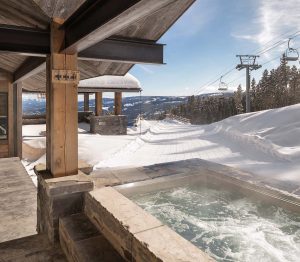
Located on a hillside for ski-in and ski-out accessibility, the home is snugged into the woods at the rear yet situated to enjoy view corridors throughout.
The slope from the back to the front of this home influenced how the architect defined access and circulation. The drive up to the home traverses a series of switchbacks that lead to the garage on the lowest level. Here, there are also areas for mechanical systems, a bunkroom, and a wine cellar — none of which need natural light. There’s a rec room on the lower level, too, one that does offer windows. “You can hang out and watch movies or play billiards,” he says. “It’s quiet and away from the bedrooms.”
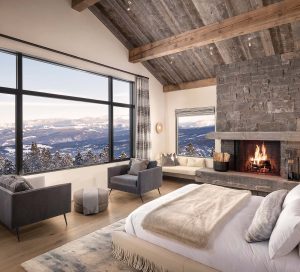
The primary bedroom, which is on the upper level, features a fireplace and secluded views.
Above, the middle level was designed for gathering in the kitchen and dining area at the front, and for ski-in, ski-out access at the rear. Off the back is a covered porch, patio, spa, and sauna, the latter situated in its own detached structure. Then, there’s the ski run leading down to Yellowstone Club’s coveted lifts.
When the family comes back from a day on the slopes, they’re received by a house that’s a social mecca. “There’s that elk chandelier and the big white sectional sofa,” Tollefson says. “It strikes a balance between how four people spend time in a house or how a lot more people might spend time there.”
Above is one more level for the primary suite and bedrooms for guests and children, all with elevated views 20 feet above grade. The primary suite offers a fireplace and sweeping view down the mountainside.
It’s all designed, the architect says, to be consistent with its mountain environment. “Alpine architecture is something that’s kind of a European-chalet style,” Tollefson says. “It has strong, simple gables and materials, with a heavy use of stone on the lower level and then timber above.” The stone he selected is a Montana basalt, the color of the land. Timber is reclaimed wood with a patina that’s already been established. The net effect of this material palette is rugged but refined. “We’re quickly asking ourselves how to do it fresh, clean, and modern,” he says. “It isn’t just a box or a Swiss chalet with windows — what we’re trying to do is strike a balance.”
Managing the budget was important to the client, an investor who works in New York City and who has a number of homes across the country. He didn’t want to get carried away. “He’s very busy but hired us and had a lot of faith in us as a team,” Thesing says. So, Tollefson distilled his design — using two ceiling beams where he might otherwise have added 12. “There’s not an elaborate second layer of rafters, but a single layer of details — just enough warmth and texture to give it a tight aesthetic,” says Tollefson.
He relied on interior designer Jennifer Hoey, principal for Suede Studio based in Sun Valley, Idaho and Bozeman, for textiles and fabrics to soften the steel beams and structural elements he utilized. This was her firm’s first shot at collaboration with the builders from Highline, and it worked out well for all involved, architects and clients included. “We’re known for being efficient and working long distances, making the process turnkey,” Hoey says. “We were on time and on budget — which was refreshing for the client.”
The homeowner wanted a brighter palette for this mountain home — not the rustic look that’s currently so prevalent. And the timing was good — Suede Studio’s Phases Collection of bath and kitchen accessories was recently added to Rocky Mountain Hardware’s network of 400 showrooms and dealers. It’s a light fusion of craftsmanship and contemporary design, which is what Hoey and her firm delivered.
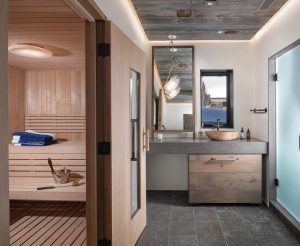
The client wanted a lighter palette, so interior designer Jennifer Hoey used bleached-walnut custom cabinetry in the baths, which feature her firm’s Phases Collection of hardware.
Suede designed all the custom cabinets, floor finishes, plumbing fixtures, door hardware, appliances, and tiles. They selected the materials and recommended them to Highline. “Then the furnishings were turnkey — even some of the artwork on the walls,” she says. “The art is by Kene Sperry, a local photographer.”
In keeping with the lighter stone used by the architect on the fireplace, Hoey called for white-oak floors and custom, bleached-walnut cabinetry. “I made the sample, and the contractor finished it out,” she says. “Then we added custom-designed window treatments and decorative lighting.”
Highline’s Thesing credits Hoey with balancing the home’s scale and proportion with her furnishings and interior design. They complement the ceiling height relative to windows and room size. “It works for a couple with a fire in the fireplace, or 17 people on Christmas morning — you feel equally comfortable,” he says. “The colors, tones, and textures work together to create a more intimate human experience.”
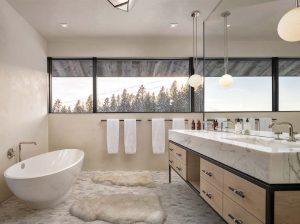
The home’s rustic-modern vibe is consistent throughout, with finishing touches on display in every space.
That’s what the architect was seeking all along. “It’s a modern house that’s all white, which is kind of a lot, but it’s timbered in dark wood,” Tollefson says. “The contrast in textures is a mechanism to scale it and make it more intimate.”
The Big Sky house achieves its desired goal as a home base where a family can ski with ease. It works overtime to maximize the views around it, and it brings people together at every level for interaction. Most impressive, though, is that it was created by a collaborative team of design and building professionals, each with strong connections to Bozeman.
J. Michael Welton is the author of Drawing from Practice: Architects and the Meaning of Freehand (Routledge, 2015). His articles have appeared in The New York Times, The Washington Post, Metropolis, Dwell, and The News & Observer in Raleigh, North Carolina. He is editor and publisher of the digital design magazine architectsandartisans.com.
Zak Grosfield is a professional architectural photographer specializing in architecture, commercial spaces, and luxury real estate. A Montana native, Grosfield grew up on a cattle ranch in the Crazy Mountains near Big Timber. He owned several successful businesses and even served as a Montana Highway Patrol trooper before discovering a deep passion for architectural photography in 2016. As with everything he does, Grosfield pursues the artform with an unwavering work ethic and relentless determination — and has a lot of fun in the process; zakaraphotography.com and @zakaraphotography.




No Comments